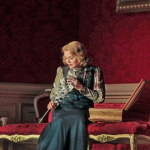Born in Portland, Oregon, the great Esperanza Spalding a female bassist and singer performs in ” Festival de jazz de Vitoria – Gasteiz” located in Vitoria, Spain. Esperanza Spalding plays upright bass and also electric bass. She is one of the female bassist that I’ve witness who has mastered the bass. First song of the festival is titled, ” hold on me”. The beginning of the piece begins with Spalding singing great melodies and lyrics with also responding with her upright. Her communications with musicians show how great discipline they have to work with her singing and not playing over her. She ends the first piece with a long voice line which surprised the audience with her great voice. Spalding has great Melisma skills with her voice which leads her voice to what ever shes playing on the bass. Her second piece “smile like that” it’s more of a modern jazz piece which starts out with a Bossa style and leads into a modern jazzy pop tune, like Herbie Hancock. The piece sounds very dissonant on the solo. Soloing on dissonant changes can be difficult for a musician to lose focus on the changes. Her winds section really take their solos to a new level. And the best part is, the bass just follows along with whats happening. Jeff Lee Johnson is the guitar and he sounds very versatile the way he switches from a jazz sound to a heavy rock sound. Every time he changes the sound, he also changes the melodic style of his performance and solos. The third piece is titled, ” Cinnamon Tree” and she grabs her electric bass which for me is just amazing. Her tone on the electric bass is incredible and just for a fact, finding a great tone on the electric is sometimes complicated. Her bass sounds as if she were to use the neck pickup, but shes adding a lot of rhythmic elements that sound like she was influenced by Jaco a bit. On the ending solo, Jeff Lee Johnson takes a solo and he pulls out his blues sound which could influenced by B.B King or other blues guitarist. This piece mostly focuses on Johnson’s guitar solo throughout the end. Spalding’s wind players are also versatile in which they do chorus lines while the solos are happening. Her fourth piece is titled, “Black Gold” which starts with a gospel style. This piece features Spalding and her trumpet player Igmar Thomas on voice. Her fifth piece “Radio Song” could be compared to soul bands like James Brown but incorporated with jazz. On that same piece, Spalding announces all of her musicians that performed on this festival which are, Jef Lee Johnson – guitar, Leo Genovese – piano, keyboards, Jeff Galindo – trombone, Corey King – trombone, Daniel Blake – tenor sax, Aaron Burnett – tenor sax, Tia Fuller – alto sax, Igmar Thomas – trumpet, Lyndon Rochelle – drums, and Chris Turner – vocals. Esperanza Spalding has been one of the female bass players to play seriously and professional. Her communication throughout her instrument is something that other players could take into consideration and use it for their performance as well. https://www.youtube.com/watch?v=3Js_PDyH71g
Category: Concert Review
Alarm Will Sound Performs Aphex Twin and Music from ‘Hannibal’
On May 13, 2017, Alarm Will Sound performed at Merkin Concert hall for 2017 Ecstatic Music Festival. They totally performed five tunes: Aphex Twin -minipops 67, Tyondai Braxton – common Fate, Brain Reitzell -Hannibal (Selection from the TV Soundtrack).
Alarm Will Sound is a not name of recording company, it is a name of chamber orchestra. It has twenty member and they focusses on recordings and performances of contemporary classical music. Many people describes their perfomances as “equal parts exuberance, nonchalance and virtuosity.

They’ve worked and arranged Aphex Twin music for 15 years. They love Aphex Twin music so much. They’ve found challenges from Aphex Twin music that how to imitate the electronic sounds of using musical instruments. Their achievement and challenges was succeed as you hear their performance of Aphex Twin.
First tune that they performed was great. I compared both original track by Aphex Twin and theirs. They couldn’t imitate 100 % sounds of music but, they performed almost same as original track. I think it is very difficult to find the electronic sounds from acoustic instruments, I was very surprised their efforts. They imitated sound of synth bass to use brass, electric snare drum to use clapping, some kind of wind sound to use violins, etc. They used original voices from Aphex Twin.
Common Fate by Tyondai Braxton is 21 minutes music. Tyondai Braxton is an American composer and musician. Mostly he composes music like New Music and experimental rock. I couldn’t find much information about this music. What I observed this music is very simple and repetition melody each movements?
The next tune, Brian Reitzell – Hannibal (Selections from the TV Soundtrack). It is about 15 minutes. They played sound track from Hannibal, is an American psychological thriller–horror television series developed by Bryan Fuller for NBC.

It sounded very similar as “Crumb, Black Angels, Ensemble Intercontemporain”. I think it is similar because both sounded horrifying and creepy. About 6 minutes of this tune, you can hear multiple percussions playing. It sounded atonal. I heard very funny sounds like from “Tom and Jerry” but I don’t know what that is. It has so many dynamic changes especially timpani.
‘
Norah Jones Live at the Baloise Session
Recognized Jazz singer Norah Jones performed at the Baloise Session music festival held in Basel, Switzerland on November 7, 2016. The concert was aired by the Arte channel on February, 2017. A fusion of styles as well as different genres were mixed in this concert highlight the vocal, piano and guitar talent of Norah. Her voice fits every genre of music and she certainly proves it by using these varieties in her live performances and recorded albums. In this particular performance, Norah uses her classical jazz style with fusions of blues and blue-eyed soul. There are also blends of country and pop in some of the pieces. Although is was not a virtuosic performance as we expect from a jazz concert, she pulled it off by the beautiful timbre of her voice, which has an excellent way of interpretation.
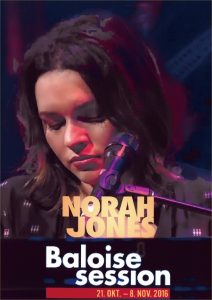
Norah begins the performance with “Day breaks“, a song that titles her last album released in October, 2016. A fusion of jazz harmony with a steady rock pop rhythm makes of this song an interesting piece. Perhaps the most relevant album of Norah’s career “Come away with me” have a series of songs people were expecting to hear. On the second track of this concert, she sings “I’ve got to see you again“, a fusion jazz piece that includes the mellow combination of musical factors that interpret the need to see the person she loves. A rhythm going constantly with a few syncopated chords from the piano and some motifs now and then, helps set the scene. An ambient guitar with doubles the piano solo in echo, a quiet bass almost silent, sets the platform for Norah’s voice to stand out. She puts the bluesy mellow tone in her vocal performance allowing the piece to be felt.
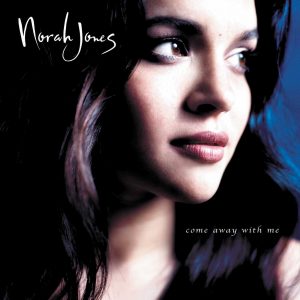
Jones performed other hits such as “Burn“, “Out on the Road“, “Tragedy“, “Sunrise“, “Don’t Know Why“, among others. This was a concert with moments of emotion and sparks but it was not 100% spectacular. Jones is not the most expressive person on stage which is particularity strange due to the sweetness of her voice. The other musicians were not great at all. There was no Jazz coming out of them. They sounded more like pop musicians than Jazz, which kills the flavor of it. She should’ve stick with one genre, either Jazz or Pop, but the mixture didn’t work in this case. In general it was pulled off thanks to her talent, but it could’ve been marvelous. Lots of fusions are arising nowadays, some of them work other don’t but it’s always good to explore new venues. The key element is having the right people to perform, because that will affect no matter how talent the artist is. Norah sounds way better in other performances and recordings, specially when she is accompanied by great musicians. Although this was not her best performance it does not devalue her talent. She is an amazing singer and musician and she shines specially when the instrumentation is limited. This lets her talent blossom.
https://www.youtube.com/watch?v=i8BOLObfKHU
Sounds of the World: A Synthesis of World Music, Sampling and Soundscapes
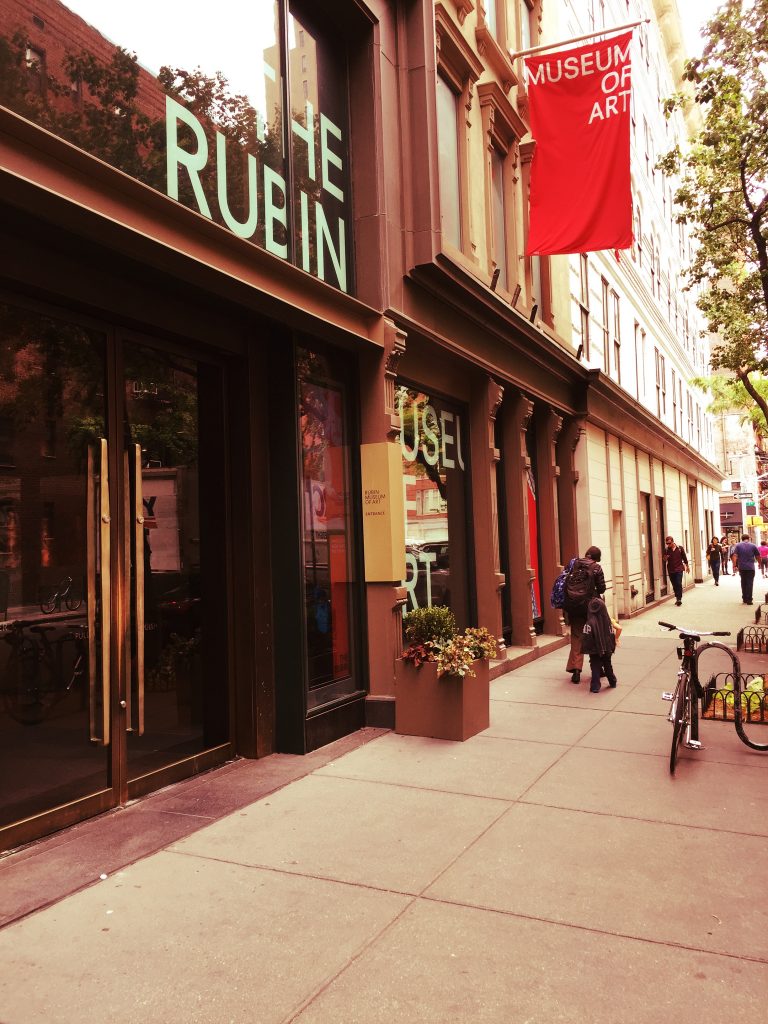
Inspired by Sacred Spaces, the exhibition held in the Rubin Museum of Art NYC, which explores the soundscapes of the Himalayas including their winds as well as the soundscapes of the most high located buddhist monasteries, I decided to take further the concept presented by the exhibition and explore a few sound concepts that are shown in the world today. As a manner of execution I am also including the concept of sampling. The reason is that thanks to the advancement of sampling technology, we can experience the perception of this sounds without leaving home. In this journey we will explore not only what this particular exhibition offers, but also how the world sounds and how the people of the world transmits music. During my visit I did some sampling myself in order to capture the sounds presented in the exhibition to share with you.
I am going to divide this study in 4 parts. The first part is going to include a review of the exhibition with sampled sounds of all the recordings shown there. Secondly, we will explore the sacred sounds of the world. This is going to be in relation to people around the world, how they project music in a perspective considered by them as sacred. Next we will explore culture expression through music by quickly analyzing how people make music around the world. Lastly, we will explore 4 natural soundscapes of the world, fascinating samples recorded in remote parts of earth. Note that every single audio, nor picture I’m sharing was not downloaded from the internet. They belong in part to sound libraries set for Kontakt, a virtual instrument that executes sampled material. These samples were rearranged, mixed and mastered by me, for the purpose of this study. So, I invite you to…
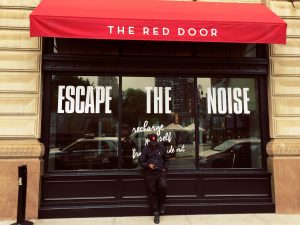
THE EXHIBITION
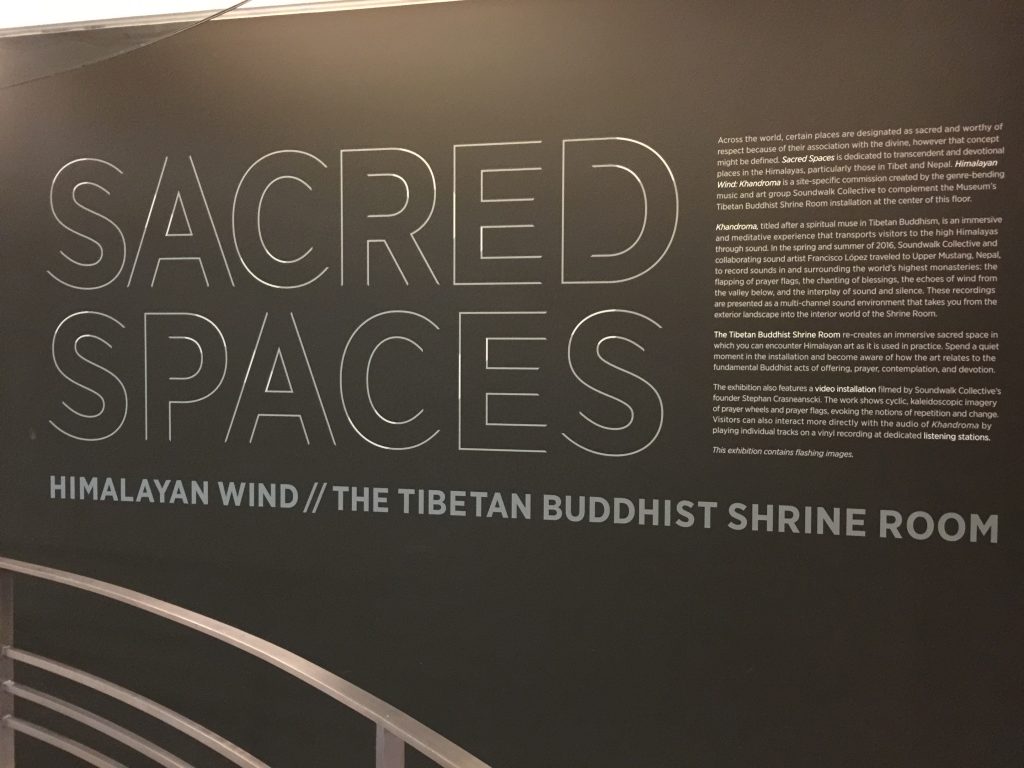
Not too much to see on the forth floor of the Rubin Museum, but a lot to sense. There are 4 different spaces that offers these recordings in order to sense them differently. The first one is a hallway with 2 screens projecting holograms. They have seats and headphones for people to sit, listen and watch while entering in a estate of meditation. At one end of the hallway there are 3 turntables with headphones for people to listen the recordings in vinyl.
HEADPHONES
HEADPHONES 2
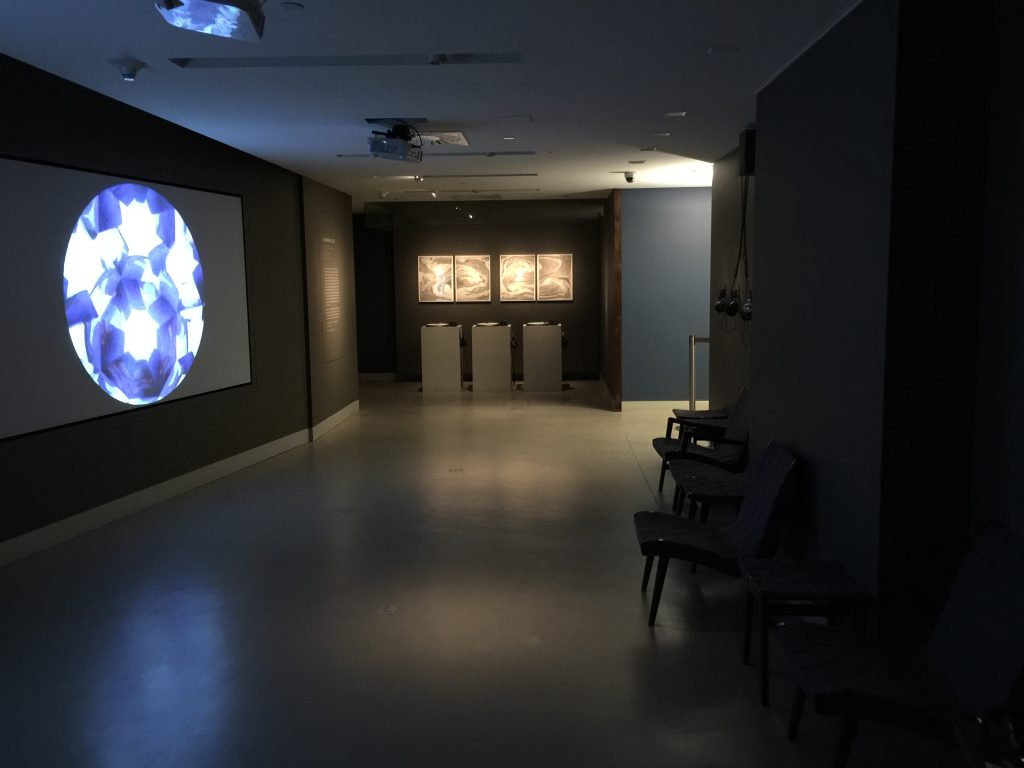
VINYL

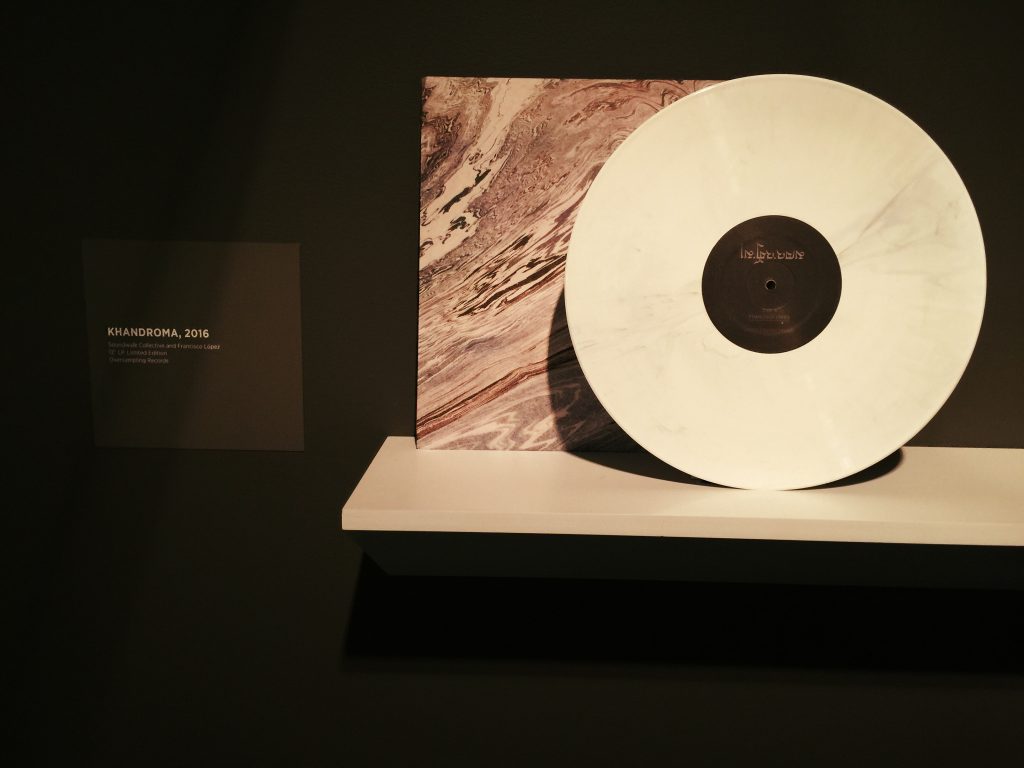
The next room is a the shrine room. This space was conditioned with elements of a buddhist prayer room. The sounds played there are the monastery sounds recorded in the Himalayas. The experience is interesting knowing that by only listening I felt cold. Maybe the sound makes that effect but it surely drives the senses to explore something different.

THE SHRINE ROOM
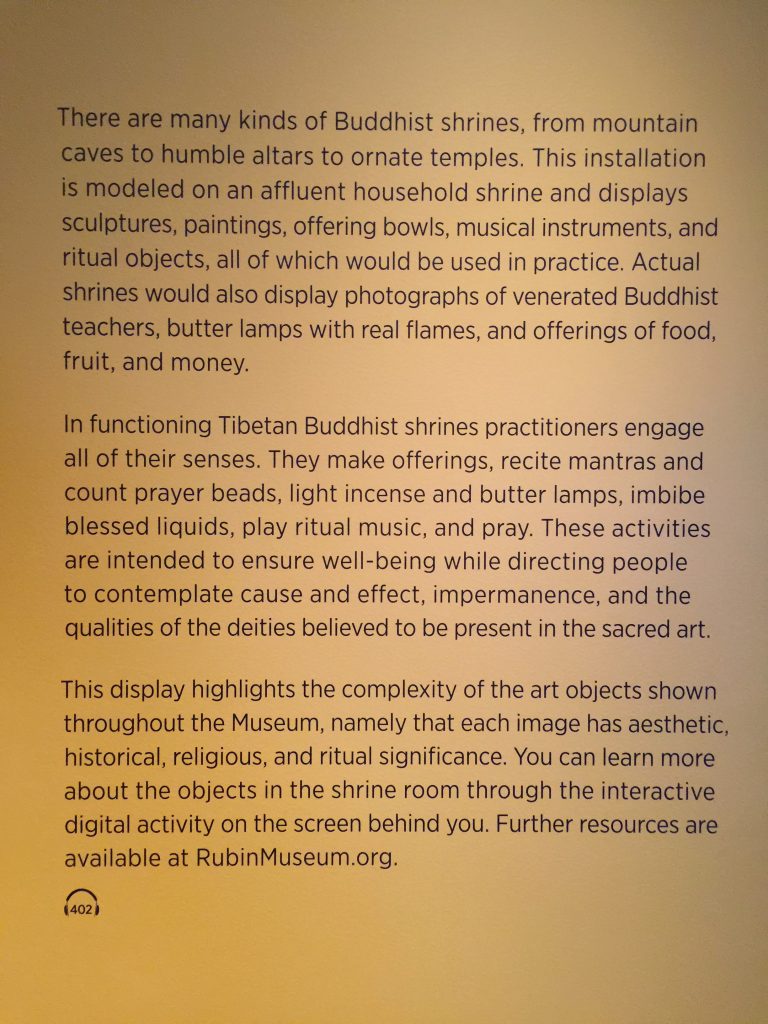
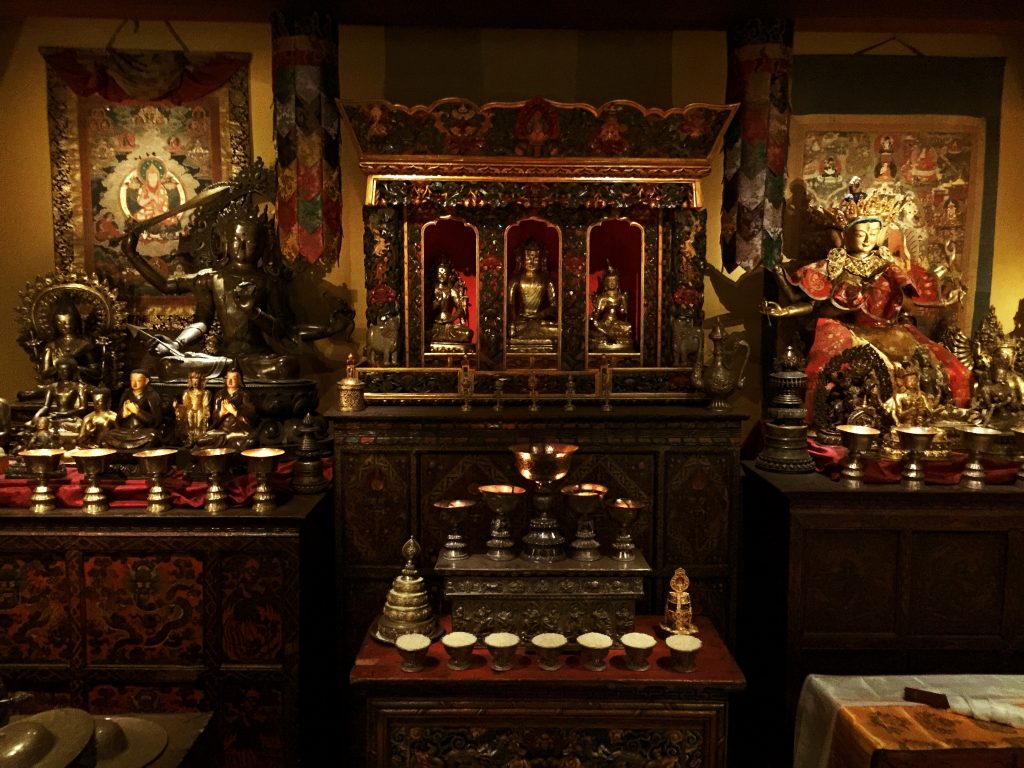
The most important part of the exhibition is a sound room conditioned and structured to play the sound recordings with sound proof capabilities. It offers 2 tower speakers one at each end and in between there are several studio monitors side by side playing the wind sounds. The main speakers play the soundscapes focused on closed spaces whereas the studio monitors play the open soundscapes environment.
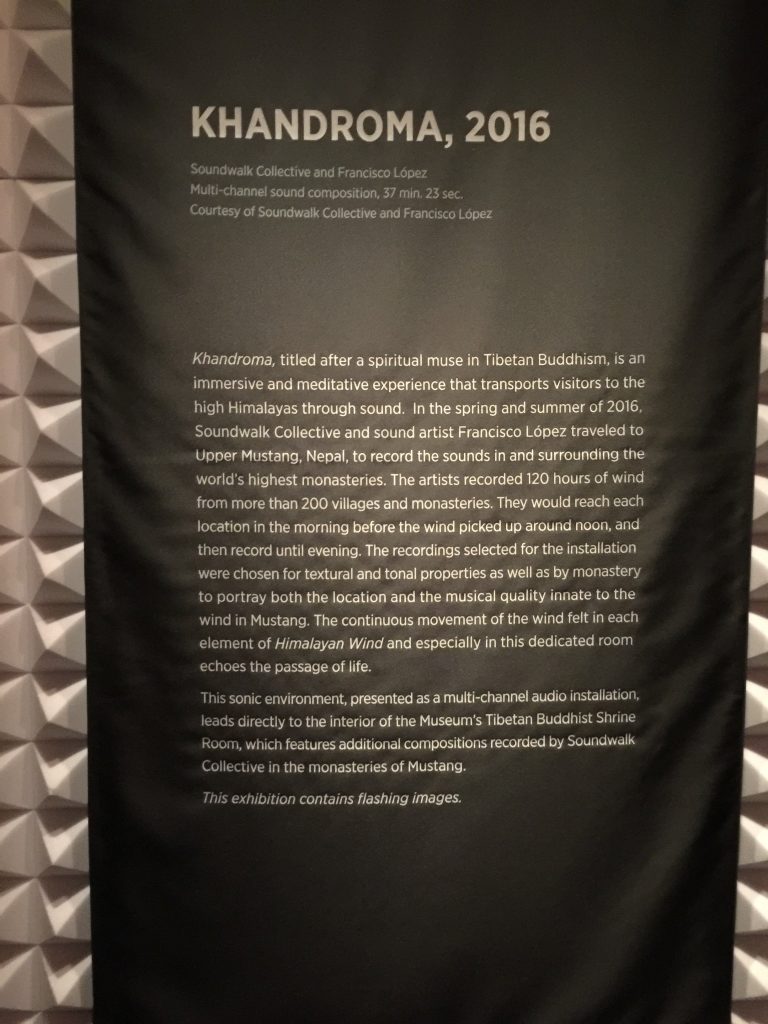
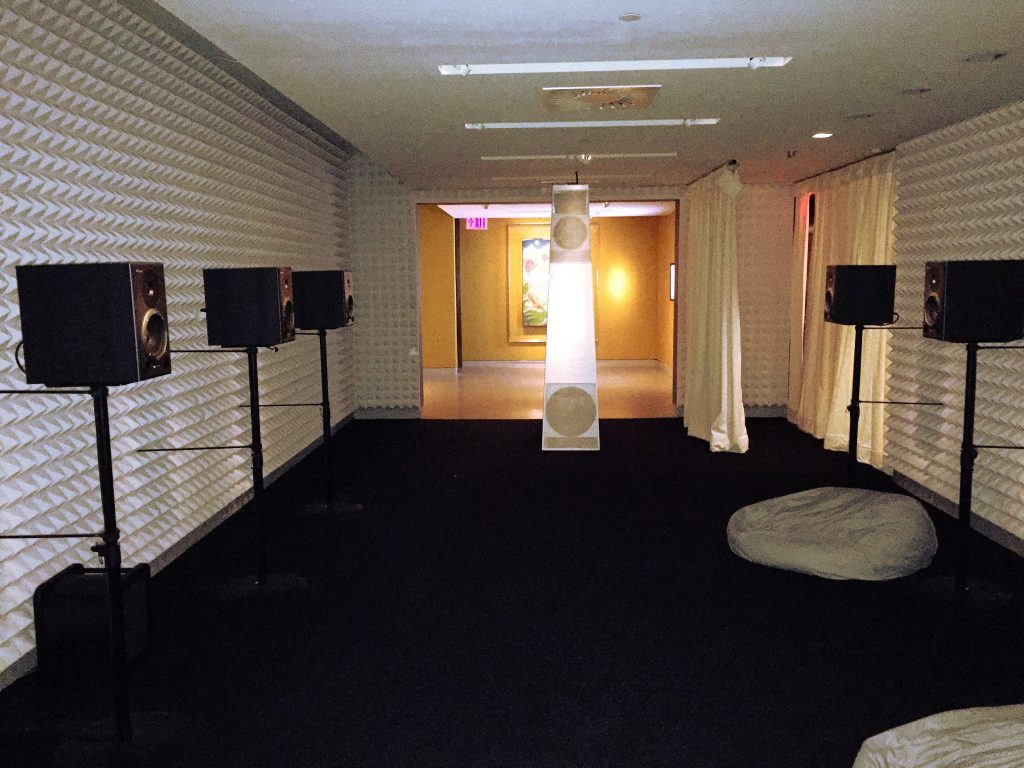
Front speaker
back speaker
side monitors
I managed to collect high quality samples from these devices thanks to my Zoom H6 Recorder which offers top professional quality sampling. This last sample of the exhibition was recorded while I walk thru the room side by side.
Walking
Although the exhibition name is Sacred Spaces, the soundscapes recordings relate more to open spaces rather than sacred places, that is why I think the title is not completely accurate and its more relating to religious disciplines such as meditation or yoga. On the bottom floors of the museum there are exhibitions with more visual content focusing more on the sacred aspects of these asian cultures. 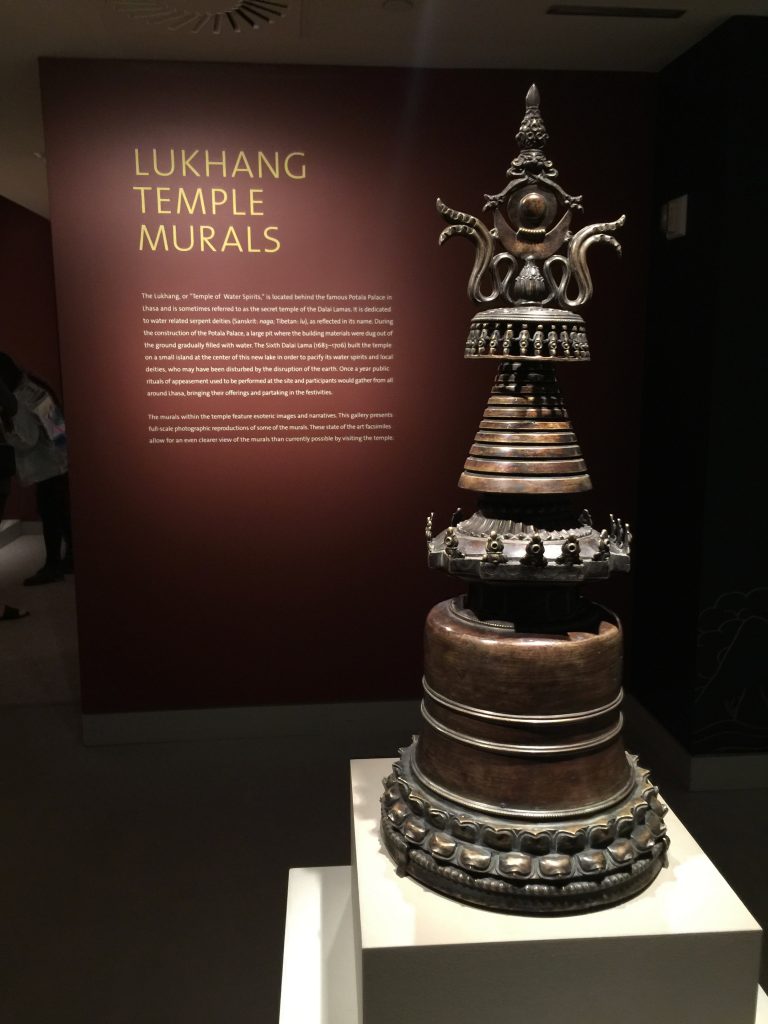
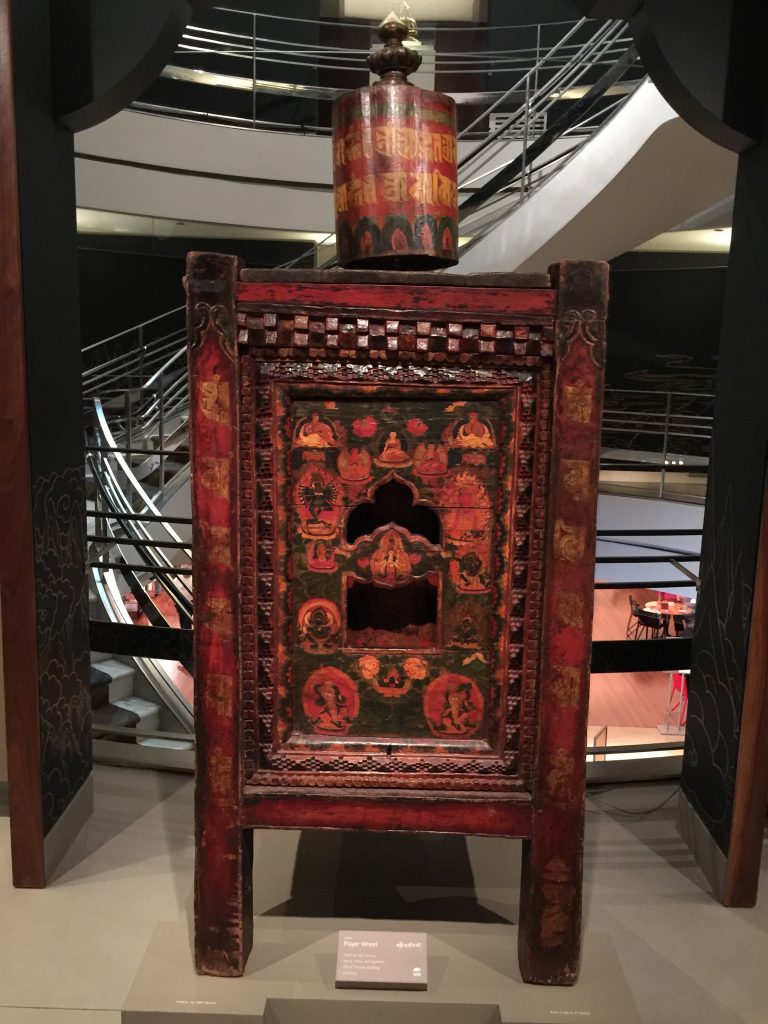
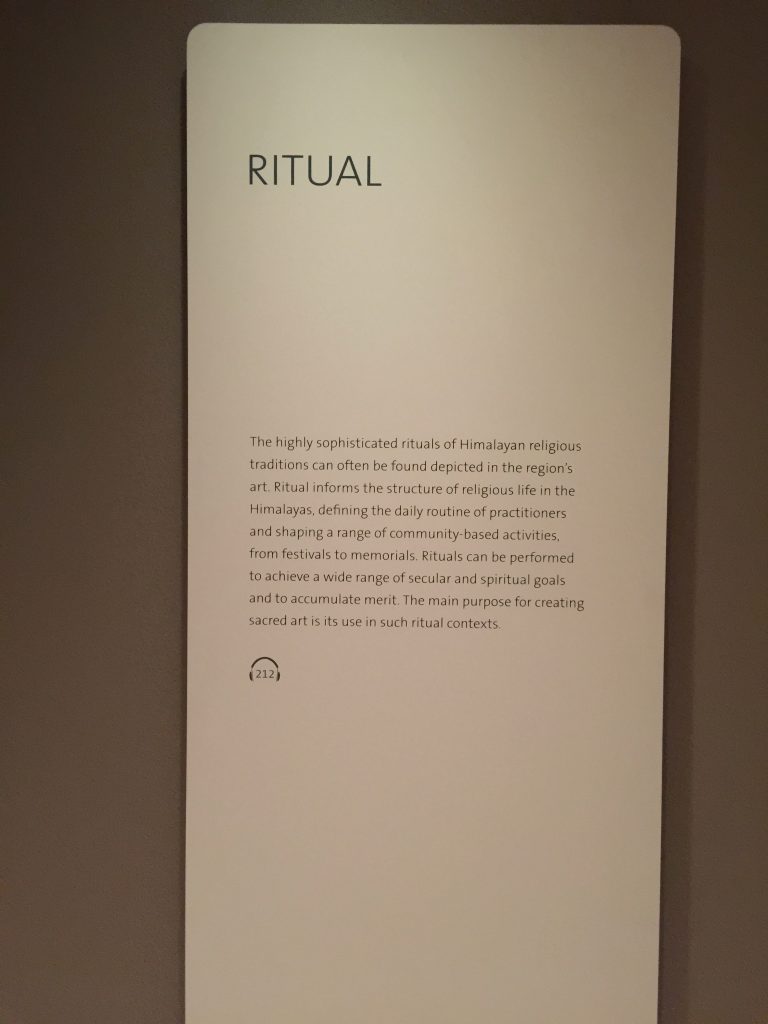
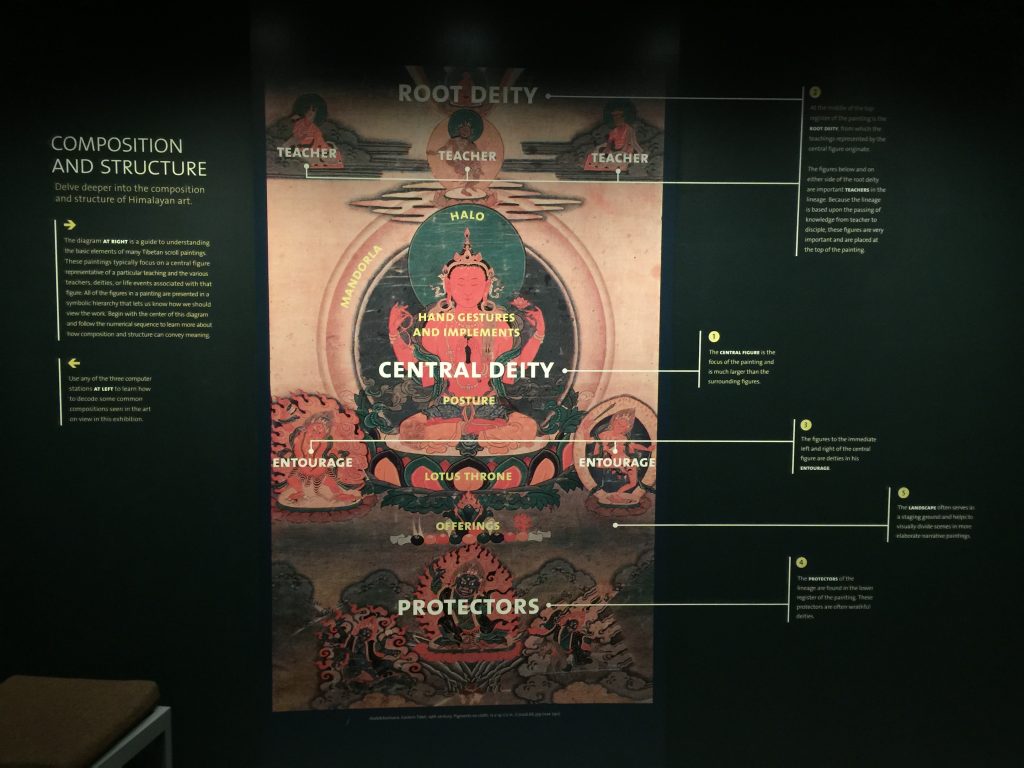
HOW PEOPLE WORSHIP
The world is a fascinating venue full of color and variety. People around it have different beliefs, credos and rituals. However, the all have one thing in common and that is music. This is an important element for every human being because it’s a way of expression. There are different religious practices and there are different sacred sounds. In this section, we will explore some of the sacred sounds around the world. How people sing or chant their sacred music in order to worship what they considered divine.
First of, in North America, the Native Americans chant their war and tribal chants. The following audio was sampled from an original Native chant in the United States.
Moving next to South America, more exactly Peru, a Quechua song worshiping Pachamama of the goddess Earth. The accompaniment is not part of the traditional ritual, but is was adapted in modern rituals.
Heading East to Europe we can find the Gregorian Chants and the Mystic Songs of the Roman Catholic Church.
Moving South to Africa, the Protestant Church reaches several parts of the continent, forming choirs of worship to Jesus.
In Malawi Africa a traditional tribal chant sang by a girl.
Moving to the Middle East an Israeli woman sings a traditional Jewish Psalm.
We will end this sacred journey with a sacred mantra.
HOW PEOPLE SING
Our next journey explores how people sing around the world. Popular music differs in cultures according to customs and languages. It is amazing how music sounds different as we move from place to place, maintaining and interest and admiration. All the music around the world is wonderful.
Let’s begin at the Caribbean with a Jamaican reggae. This excerpt contains the first half with only vocals and the rest with the accompaniment. Please focus on the vocal interpretation since this study is focused on vocal interpretation and soundscapes.
Moving to the Alps in Europe where the Swedish Yodel their famous folk music.
In Bulgaria a traditional folk song.
A beautiful traditional Ukrainian waltz.
In North Africa, Algerian hip hop artist and rapper sings a popular Algerian hiphop song.
Moving South to Cameroon a popular song with a Bossa feeling.
In Guinea, a traditional song.
Moving to Asia, a Turkish chant.
More to the Middle East, an Irani chant.
At the Northside of Far East Asia, a Mongolian quintet performs a traditional piece with drones and vocal percussive effects.
Moving South to China a duet performs a traditional piece.
Southwest China, a Balinese traditional song performed by Philippine singer.
HOW THE WORLD SOUNDS
This was a journey of sound and music exploration focusing on the soundscapes from places considered sacred. Then there was an analysis on how people uses music to practice religion and worship, ending on an exploration of traditional and popular music in around the world. Now we will end exploring 4 different soundscapes that are almost impossible to reach. Welcome to Geosonics. Geosonics is a sample library developed by English company Soniccouture. This library offers a huge library of samples recorded by one of the world’s leading recorders of wildlife and nature, Chris Watson. The first soundscape is ice and water. This particular example was recorded in the Icelandic glaciers south the North Pole.
Secondly, we will move north to the North Pole to catch the sounds of the polar winds.
In contrast with the freezing weather, this next soundscape was sampled in the humid swamps of Africa. The notorious sound in this example are the African frogs.
Finally, in the dangerous Australian Outback there is a system of wires of interconnection, This example shows how the wind hitting these wires make a particular sound.
Universal Melody Brass Band
I went to see the Universal Melody Brass Band at The Stone curated by Steven Bernstein. Finding the venue was an experience of its own. From the outside the Stone looks like an abandoned shop; and the only thing that informs you that you have come to the right place is a bumper sticker on the door. Once inside you’ll see how small the venue really is. Chairs are pushed and cramped together surrounding a small circle of instruments and music stands, and by the time I arrived it was almost full. But none of that mattered once they began to play.
Run by Steven Bernstein (playing trumpet), Universal Melody Brass Band also features Frank London (trumpet), Art Baron (trombone), Curtis Fowlkes (trombone), Matt Darrio (sax), Oscar Noriega (sax), Marcus Rojaz (tuba) and Billy Martin (drums). They played a variety of Jazz favorites as well as original compositions by Steven Bernstein. Unfortunately there was no programs, cell phone use was prohibited and the venue was very dark so I couldn’t write down the names of any the pieces performed. However, one piece that really interested me was one of these original compositions. It was heavily influenced by Slavic music, which is similar in its use of modes. But because it was a brass band the instrumentation created a musical juxtaposition. A brass band in such a small space created another surprising juxtaposition. At first this big sound was quite jarring and hard to process. However, the sound soon washed over me and the effect was that the audience became one with the space. Being so close to the musician and on the same plane created an intimacy that can’t be replicated in a recital hall or on a stage. I actually felt displaced from my body during certain pieces because I was so caught up in the music, especially during the piece I mentioned before. In such a space with such a big band, you might expect that the soloist might be hard to hear but Bernstein managed to arrange the pieces with such a balance and fluidity that I couldn’t even hear when the other instruments backed off and came back in.
This group was also different because instead of having one or two main soloists, all of the musicians were virtuoso soloists on their respective instruments. And each musician had their own style of improvising which made for these really distinct transitions between solos. While the trumpets and sax solos were all fun to listen to, what really caught my eye was Marcus Rojaz on the tuba. Due to the nature of such a large instrument continuously fast moving passages are nearly impossible. That being said Rojaz combats that quality by creating these harmonically complex improvisations often sharpening the forth scale degree and flattening the 6th unexpectedly. And rather than playing long held out notes, or slower moving continuous passages, he uses the negative space (rests) to create more interesting rhythmic phrases. The trombone player Art Baron used a similar rhythmic style, but also incorporated quick slides into his improvisations. Bernstein played mainly a valved trumpet but also had a slide trumpet on certain songs. When he took solos on the slide trumpet he combined the fast moving phrasing common to the trumpet with fun glissandi.
Overall going to see the Universal Melody brass band was a treat. I would definitely recommend anyone to go and see them if they are ever playing in New York City again. However, if you do go you should definitely find a venue that is in a smaller space. I would have definitely enjoyed watching the group on a stage, but it would have lacked the intimacy that I experienced at The Stone. And in terms of a venue, if there is any experimental group or artist you would like to see, check out The Stone to see if they are playing. Trust me, the venue is an amazing experience of its own. Just make sure that when you go that you bring $20 in cash. Tickets are not available in advance.
Africa in the Americans: Rhythmic Connection of Cuba and Brazil
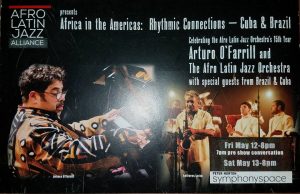
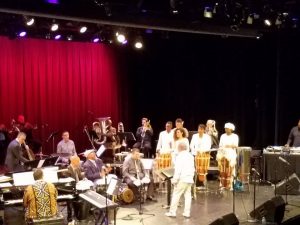
https://www.youtube.com/watch?v=gr5ULqG8Y00
Africa in the Americans: Rhythmic Connection of Cuba and Brazil
Africa in the Americans: Rhythmic Connection of Cuba and Brazil was a performance at symphony space. The orchestra is led by pianist, composer, and director Arturo O’Farrill. Arturo O’Farrill is a jazz musician, a pianist, composer, and director of the Afro Latin Jazz Orchestra. He is notable for Afro-Cuban jazz. He has received two Grammy Awards and four Grammy nominations. He also trains and utilized other musical forms such as free jazz and experimental hip-hop. The orchestra is consist of 4 trombone, 4 trumpets, 5 saxophone, drums, bass, piano, bongos, congas, Brazilian shaker and DJ booth. The list of instruments I could expect what it would sound like. I expect it to have a wide range of dynamic covering from low to high tones. I was sitting on the upper level to the left just proximally 10 feet away from the stage. Taken this into consideration this perhaps affected the way I perceive the music. Rather than being in the middle where is equal music dynamic distribution.
The movement has a dense texture because numerous of instruments playing simultaneously. Instruments such as the saxophone and percussion instrument pitch and timbre are distinctive. It is difficult to perceive the piano, shaker, and the DJ instruments. When many instruments are playing simultaneously. The chances of each instrument drowning out the other are likable. Continuing, each instrument was playing repetitive notes. Also, they are using the staccato technique. Sometimes there would be trumpet and saxophone come in to play a melody on top of the uniform base. The uniform base is formed by varies of instrument repeating notes. When the melodies played by the brass instrument created a contrast and also highlighted their melodies. The conductor would also signal for sforzando. The brass player would play staccato notes that are a higher pitch. This is also another method of this motif to have short breaks then proceed back to their uniform melodies. During the 3:00 time period there is a small part for soloing trumpet. The rest of the instrument pause temporary with exceptional of the bongos. The bongos would steady continuously strike along the solo trumpet. This technique provided foreshadow sound and accompanied the trumpet. This instrument does not exceed the pitch of the trumpet. The audience could focus on the sound of the trumpet easier rather than another instrument that is doing individual motif. The Dj could be heard sometimes as cutting. It has a a scracth sound. It would cut the notes up and repeat it. At the 4:31 the audience could see the utilization of unity. Each piece is continuous playing but all instrument stop at the same exact time. Rather than the constant sound, it provided breaks that give a dissonant sound effect. The orchestra ending was unique due to a utilization of sforzando. The group would make a sudden stop and quickly played again. While the bongo played its own fast pace melodic motif to also provided contrast to the uniform sforzando.
Overall the movements are able to utilize a uniform staccato base and built short solo accompany by uniform sound. They also emphasize on sforzando since is one of the main contrast points of the movement. This particular orchestra insinuates a “live” atmosphere since it has a lot of dynamic and quick tempo. In the past, I attended orchestra that utilized legato and tells a story. Those pieces insinuate mellow emotion. Additionally, I think it was able to achieve that emotion because of the minor keys, minor usage of sforzando and pitches. While these pieces remind me watching a Caribbean or Spanish parade where there are live performances. The music insinuates nothing short of excitement.
Flamenco Meets Jazz
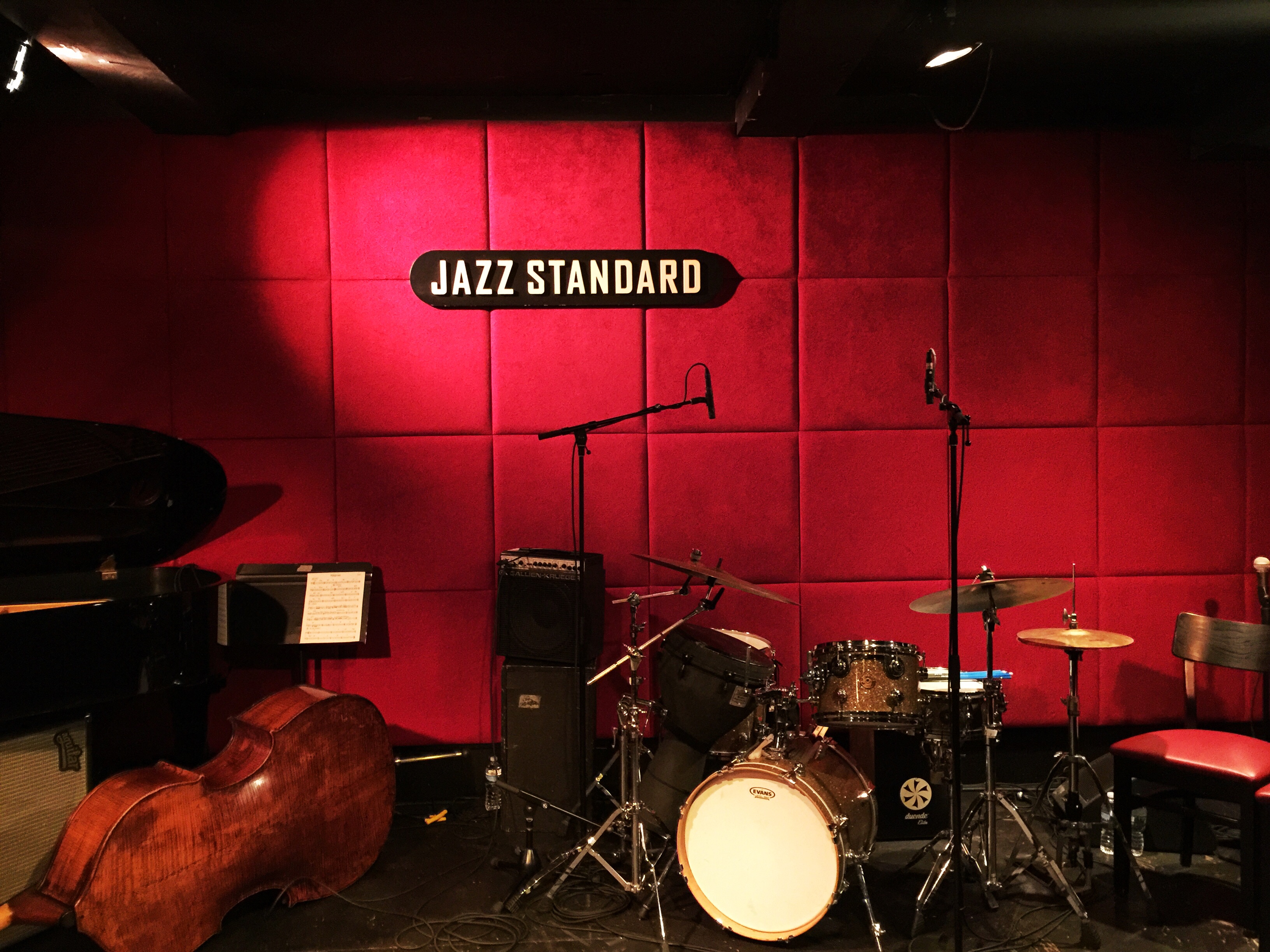
What happens when a music genre full of color, dance, movement and exoticism such as Flamenco is fusion with the complexity, syncopation and groove of jazz?
The answer is the art work of multi Grammy nominee Jazz pianist and composer Chano Dominguez.
I had the opportunity to attend one of his past presentations in New York this past month of April and it was an outstanding performance full of flavor, glamour and above all, Jazz.
In a recognition to Chano’s contributions to music, I can say that his style have had inspired great musicians such as Herbie Hancock, Paquito D’ Rivera, Chucho Valdes, among others. Chano’s style expands the boundaries of what is known as Latin Jazz which has been a style particularity derived from the Afro Cuban sound. It now reaches the old continent, more specifically Spain, to bring a new fusion of sounds which transcend a long journey from the Middle East. The gypsies from Romania traveled across Europe and settled in Spain. The cultural influence in Spain is a mixture of Eastern Europe, North Africa and the Middle East. All that combined creates what is known as Flamenco. If you want to have a taste of the Flamenco sound and visual I invite you to see Flamenco Flamenco, a film production by Carlos Saura.
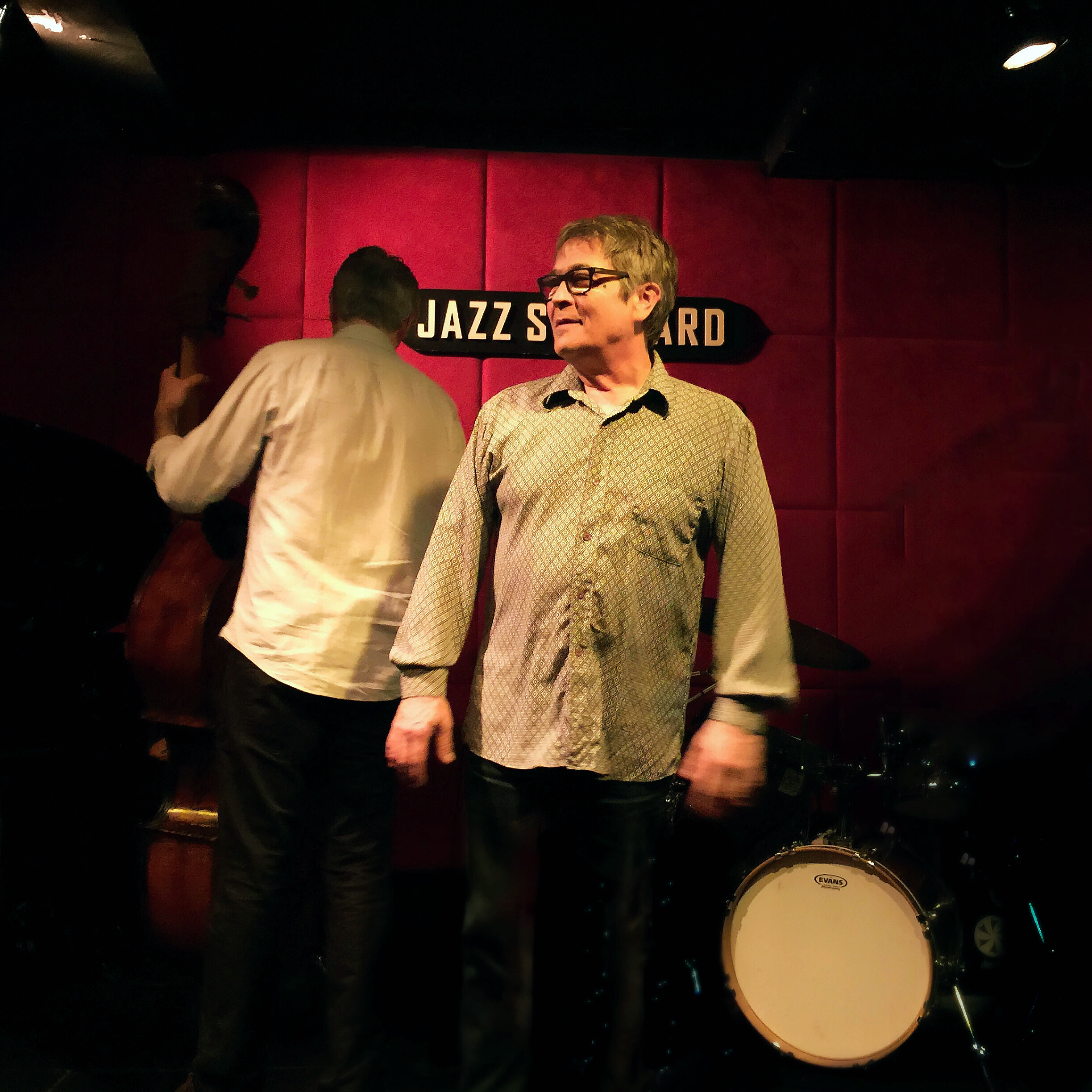
At the Jazz Standard, the Chano Dominguez Flamenco Quintet gave out a series of concerts from the last week of March thru the first week of April 2017. Chano had the accompaniment of Flamenco dancer Sonia Olla, recognized Flamenco singer Ismael Fernandez who happens to be Sonia’s husband, bassist Alexis Cuadrado, and percussionist Jose Moreno.

First of all, I want to mention the negatives. The Jazz Standard is a recognized underground club offering weekly presentations with important figures of Jazz. A good thing is that this club is one of the most affordable Jazz clubs in New York City, charging an estimate of $30 per gig. Also, they do not require the purchase of beverages of food, meaning that for only $30 anyone can enjoy a fine Jazz performance. The downside is the stage and room setup and distribution. The room is long and rectangular with a low stage. This does not allow people seating in the back to contemplate the visual aspect of the performance very well. There are also columns in different parts of the room that may block the vision of the audience depending on where they are seating on. This is an important issue, in my opinion, because in order to fully enjoy a Jazz performance it is necessary a good view specially when its a live performance. I had the chance to seat close to the stage so that made me enjoy the show a lot although the one table in front of me was a bit annoying. I guess not every venue is perfect but I’ve been in other Jazz clubs before with better setups that had allowed me to view the performance in a better way even on the times I had to seat in the back. That could be a reason why this venue is affordable, who knows.
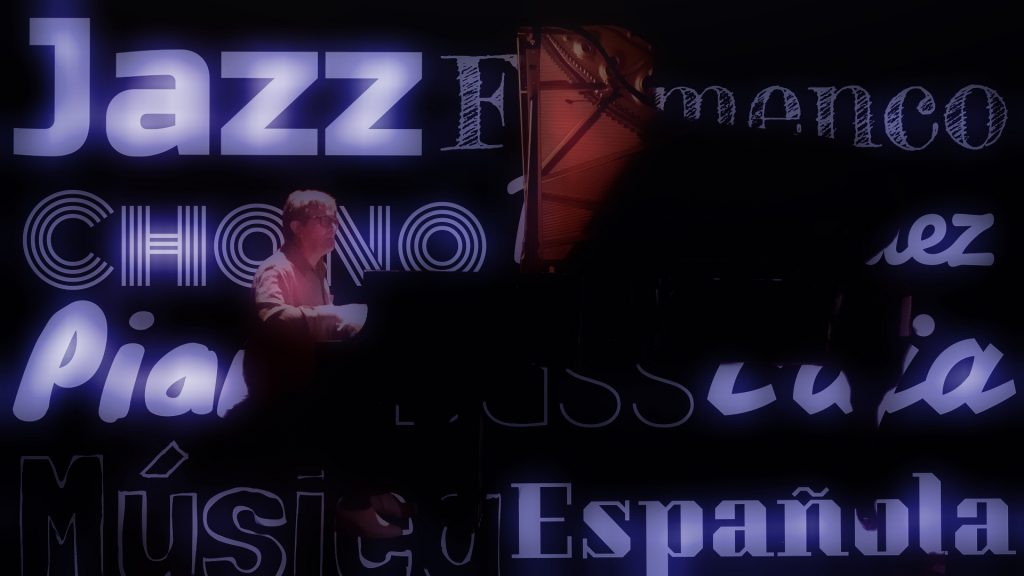
The performance took less than an hour but it was worth it. Chano began with an improvised Flamenco tune performing only instruments with no dancing and singing. After that, all the other musicians left the stage for a solo piano series of tunes. This particular solo piano performance sounded more traditional Jazz, with a few slight touches of harmonic minor scale grooves to give the Flamenco touch. The real deal became afterwards, when the whole quintet joined (including singer and dancer). Music turned more danceable and groove once the claps joined with the frequent Flamenco shouts which are particular of the genre. Colorful harmony where presented with a few varieties from the Jazz people are used to hear. In my opinion, the difference in harmony presented in Flamenco Jazz, are the implementation of harmonic minor and phrygian concepts within the harmonic and melodic structure. One of the unique features of Flamenco Jazz is the combination of these modes and scales. We usually conceptualized Flamenco Jazz as a rhythmic fusion, however this is not the only change presented. If we talk about harmony and melody, we can see that most modes are based on scales and scales are based on pitch formulas. The most common scales are the major, natural minor, melodic minor, and harmonic minor. There are others such as the whole tone scale and the chromatic scale, but these are symmetrical in their mathematical structure. in the case of the whole tone scale there are a space of one tone or a whole tone between each pitch whereas there is a semitone space between the chromatic scale. These symmetrical formulas lacks the sense of interest but they have their function. In the case of the others, they may sound different if their functions change according to their mode. The modes used in Flamenco are mainly based on harmonic minor scales. This particular sound mostly produced on the minor third interval between the sixth and seventh degree and the half step between the seventh and eight. The phrygian mode also plays an important role in Flamenco thanks to the minor second gap between the first and second degree. This sound make an interesting approach of the first degree which is a strong tone that is followed by a half step in the second degree. We are used to hear a strong tone preceded by a weak one half step below, but in this case is the opposite. This idea makes the phrygian unique. Although the locrian mode shares the same formula in these two degrees, the lack of perfect fifth makes of it a hard to use mode. The phrygian mode has the perfect fifth.

The phrygian major mode is a common mode used in Flamenco. This is mode based on the harmonic minor scale starting at the fifth degree. All of these variations set the melodic and harmonic parameters in Flamenco. But, what if we combine modes and scales within one chord or structure to create even more exotic colors? That is what Flamenco Jazz does and the one specialty of Chano’s playing. He uses often the spanish phrygian mode. This is the phrygian mode with an extra note: the major third. We can defined this as the combination between the phrygian and phrygian major modes, a combination between a major and a harmonic minor scale. This is only one example, but there are many other combinations. One combination that I have explored myself (not sure if discovered) are the combination of the first four notes of the phrygian major mode ending with the last four notes of the harmonic minor scale. For example, if we use D, then is the last four notes of the G harmonic minor staring in D and finishing with the last four of the D harmonic minor. I don’t know what the name is but I have used it and sounds great. These are one of the points that I wanted to highlight of this performance and style. There are others like rhythm, singing and dancing but they are more familiar with the basic structure of Flamenco.
Another impressive feature that I noticed in this particular performance was the instrumentation. As we know, the most important instrument in Flamenco is the guitar. Many times there are no other instruments present when Flamenco is performed. There was no guitar present in this performance. That little but important detail impressed me a lot because when I listen to Flamenco music I always expect the sound and rhythm of a guitar. The way Chano deals with instrumentation in his performances, makes a difference but never deviates from the essence of Flamenco. This is not new since other Jazz musicians have tried before. Chick Corea is one of them. However, in the case of the others, I find them to be a lot more inclined to Jazz instead of Flamenco. I can defined their style as Jazz with touches and embellishment of Flamenco. Chano is different. He maintains balance, and the amazing thing, without guitars. You don’t want it to be too Jazz nor too Flamenco. Chano is the guy for the job.
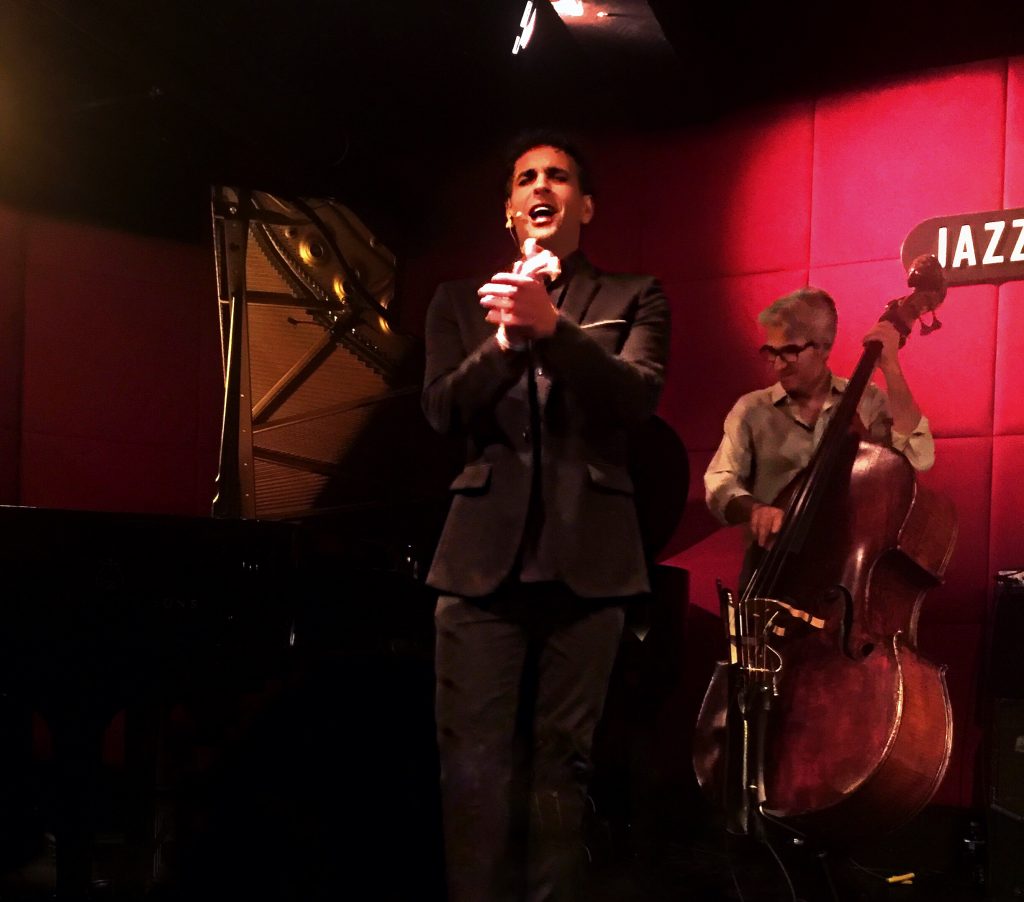
Chano met Miles Davis way back and together they worked in a few arrangements. As a tribute to Miles, Chano featured one of Miles’ popular tunes and made it a Flamenco piece. This tune was Miles Davis’ Blue in Green. It is interesting how Chano managed the arrangements in order to make it Flamenco. It was not only a fusion of Miles melody, but it included and extra feature. Chano took this Jazz Ballad and transformed it in a Flamenco poem by adding rhythm, chords and Flamenco improvisations. Not only that, he did something that was often used since the Renaissance period. He took a poem and stocked it within the tune. A poem by Rafael Alberti, a spanish poet from the Modern Era. The result was an extraordinary romantic piece well sang by Ismael.
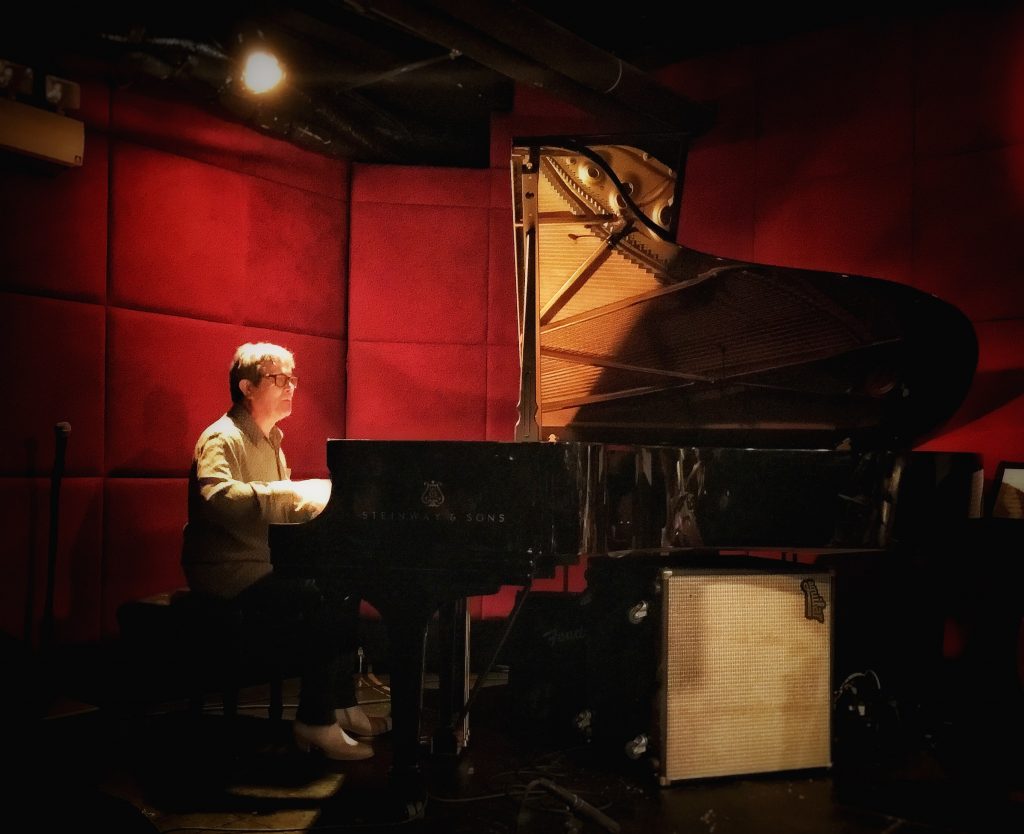
I want to conclude this review with one more interesting feature I noticed in this performance. It is commonly known that the Modern Era brought lots of innovations in the implementation of new sounds, new compositional techniques and new ways of performance. One of these innovations was the use of extended techniques, which is extending the performance of an instrument but making sound using other types of execution rather than the normal way of playing it. Chano used a common extended technique in modernism, applied in the early 1920s by Henry Cowell, plucking the strings of the dulcimer. In order to add the missing sound of the guitar that is mostly featured in Flamenco music, Chano plucked in many occasions the strings of the dulcimer of the piano. This added a special timbre, but it was even better to watch it live. It is one of the things that deviates from the common expectancy of a Jazz performance.
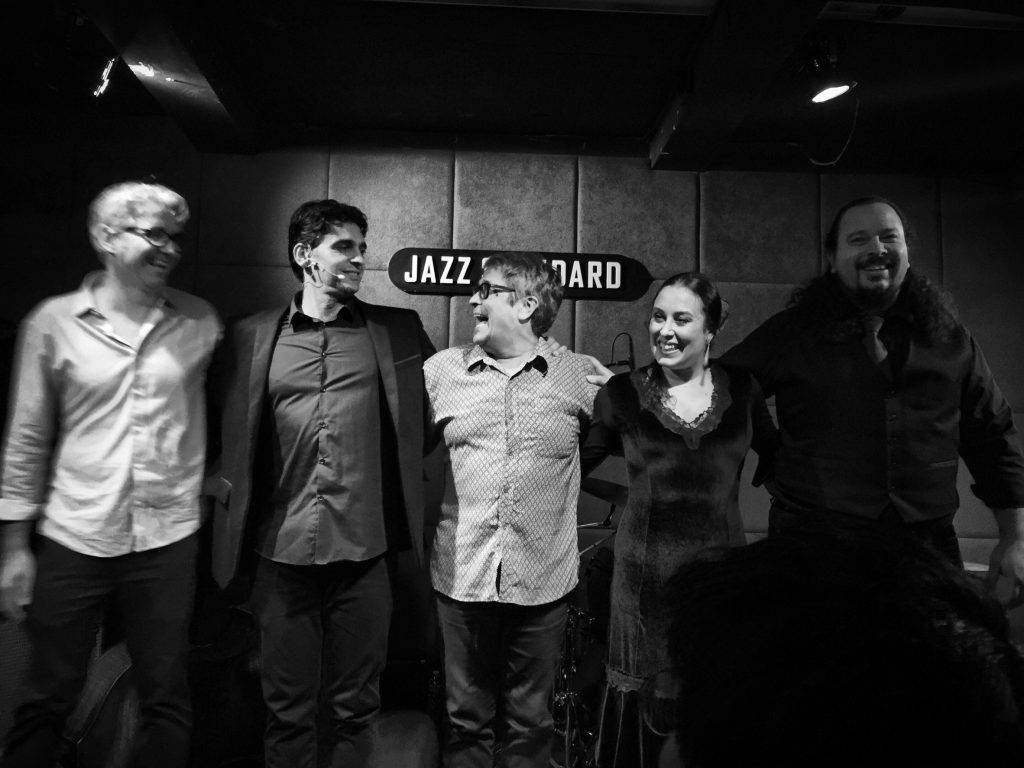
I now leave you with a taste of what I consider a great performance. Enjoy.
Michael Riesman and Ensemble Signal Celebrate Philip Glass
On Monday May 15, at 6pm, I attended a Pop Up! concert at the Miller Theater at Columbia University School of The Arts. This Pop Up! concert was in honor of Philip Glass’s film and opera music as interpreted by Michael Riesman. Arriving to the location was a long walk from the train station so it was a pleasant surprise when I found out they had a free open bar at this free Pop Up! concert event, it made for a very relaxing time after being tired from walking and then waiting on a long line to get inside. After getting settled into my seat i realized that there were chairs up on the stage right in front of the piano; turns out people could actually purchase tickets to sit right up front and center with the musicians. It definitely created a very intimate setting for the performance, just not for those who did not purchase those tickets as we could not see the musicians at all, it was all just a listening setting for us down below.
Michael Riesman was the pianist for this concert, along with Doug Perkins on percussion and Laura Radnofsky on cello who are part of Ensemble Signal. The trio performed pieces from a blend of Philip Glass’s film and opera music. These pieces came from The Hours (2002 film), Naqoyqatsi (2002 film), Dracula, La Belle et la Bete (1994 opera) and Satyagraha (1979 opera).
The music that Philip Glass composed for these films and operas were definitely minimalist, for most pieces it only used two out of the three available instruments and it was not a complex scoring, as far as i could hear. The very first piece only included piano and cello, the majority of the pieces were cello and percussion. All the pieces were calming, relaxing, and romantic, it also helped create a scene in my mind, although i had never heard or seen any of the films or operas these pieces were coming from, I was able to feel like i was watching scenes unfold right in front of me, it was quite an experience.
At the bottom i have attached two recordings i was able to get from the performance, the first one is Tissue No.1 performed with cello and percussion from Naqoyqatsi and the second recording is The Poet Acts from The Hours performed with piano and cello.
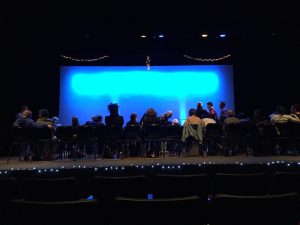
“There Will Never Be Another You” -Lehman College Faculty Jazz Quartet
On May 2nd, I watched the Lehman College Faculty Quartet perform a recital at Lehman College’s Music Building on the 3rd Floor in the Recital Hall. One of the Songs they performed was a Jazz standard called “There Will Never Be Another You.” The musicians performing were Allan Molnar on Vibraphone, Lee Marvin on bass, Robert Windbiel on Guitar, and special guests Terry Silverlight on drums, and Beledo on Piano/Guitar.
“There Will Never Be Another You” is a popular song with composed by Harry Warren and lyrics by Mack Gordon. It was famously known for Twentieth Century Fox’s musical Iceland in 1942. The songs in the film featured Joan Merrill accompanied by Sammy Kaye and His Orchestra.The song was published in 1942, and is at least since the 1950s, one of the widely known and performed standards of the jazz repertoire. “There Will Never Be Another You” has been used often in performances by many various Jazz singers and players with the ability to swing light-heartedly.
The tune was written in the key of Eb Major. The tune contains a lot of step wise motion melodically which has been used well to block chord harmonization. ‘”There Will Never Be Another You”, written in the key of Eb Major, follows a standard A-B1-A -B2 form. The melody of the tune is very noticable as it contains a sequence of two virtually identical phrases. However the second one is played a major third higher diatonically. So basically that means that the intervals are the same, and the melody is just moved a line up a major third in the key of Eb Major.
In the performance I attended by the Lehman College Faculty Jazz Quartet, their were no vocals, and the trumpet part was replaced by Alan Molnar on the vibraphone. The vibraphone may have even mimicked the melody of the vocals which sounded just as good. There was a gently yet swift swing rhythm section. With its A-B1-A-B2 form, the instrumentals of “There Will Never Be Another You” contain an unusual melody. The A section comprises two long sequences of ascending quarter notes. The B sections more or less invert the idea containing, in the main, three descending sequences of quarter notes. The overall feeling then is that of rising and falling, moderated by brief changes of direction. This piece’s careful construction is what makes it unique among other jazz standards which are a sequence of two virtually identical phrases, the second one played diatonically a third higher than the first, and followed by two more phrases that are roughly similar to the opening ones. This is a fairly fun and simple tune to learn and memorize which is why it is one of the first tunes learned by the beginner jazz performer.
Renee Fleming Last Performance
After listening on Saturday in a life radio Station WQSR 105.9 FM the magnificent Soprano singer Renee Fleming in witch was performing the opera Der Rosenkavalier by Richard Strauss that translated means The Knight of the Rose, I was amazed of how well this singer does her performance just by listening her voice on the radio was very powerful. Sadly, before the performance started, one of the radio station Broadcaster said that this was going to be her last performance. In addition, after decades of Renee being the stage performing numerous operas, today she will perform for the last time in the Metropolitan Opera House.
The opera story consist of an 32 years old wife “Marschallin” that fight all along with her unsustainable marriage. As a result she has an affair with a young man that is half her age “Octavian“. And at the end Octavian leaves Marschallin for some other woman that is younger.
This opera consist of five main character:
Marschallin: Renee Fleming
Octavian: Elīna Garanča
Baron Ochs: Günther Groissböck
Faninal: Markus Brück
Sophie: Erin Morley
The instrumentation of this opera in witch Strauss composed consist of: three flutes (piccolo), three Oboes (English horn), three Clarinets and three bassoons (contrabassoon) on the Woodwind Family. Four French horns, Three trumpets, Three trombones and bass tuba on the brass family. Celesta, timpani, bass drum, cymbals, triangle, tenor drum, snare drum, jingle bells, tambourine, glockenspiel, ratchet, and castanets on the percussion family. Two harps, sixteen violins I, sixteen violins II, twelve violas, ten cellos, eight double basses on the string family.
This is an opera comique in which is an type on opera that not necessarily need to be to laugh. In addition, this type of opera is current in France and it is characterized by have a spoken conversation and an opera on a lighthearted theme, typically in French and with spoken dialogue.
when it come to the music, every scenes I can say has its own color I believe that when Strauss was compassion this opera he was trying to communicate emotion with the orchestra alone. In every section that Marschallin was around with Octavian the music was consonant and playful. however, when her husband was in the scene the bassoon played and more low pitch instrument where playing like the tuba and the trombone.
To conclude, I would wish to be their seeing life her las performance to explain the costumes and the decoration of the stage, but with only the radio was Amazing to listed to this great opera by Strauss figuring the last performance of Renee Fleming.
